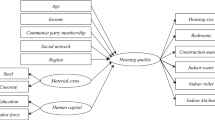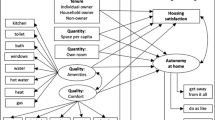Abstract
The aim of this paper is to analyze the housing conditions of households in Tunisia, for which we develop an individual indicator of housing adequacy based on dwelling attributes and household size. This indicator has two main advantages: it relies on less arbitrary weights, and it takes the multidimensional housing facets into account in the aggregation process. Using data from Tunisia’s national survey on family health and social transformations for two periods (1994 and 2006), our findings are comparable to those from an arbitrary weighting scheme, the most commonly adopted in the literature of multidimensional well-being. In order to identify households suffering from housing deprivation, we develop five housing deprivation thresholds related to some public health issues. Our results suggest that quality-based efforts should be made to reduce the gap in housing conditions between coastal and inland regions and between urban and rural areas. These efforts should be aimed at reducing housing deprivation and preventing health vulnerability among deprived households.



Similar content being viewed by others
Notes
These dimensions are: Legal security of tenure; Availability of services, materials, facilities and infrastructure; Affordability; Habitability; Accessibility; Location; and Cultural adequacy. See Article 11(1) of the Covenant for more details.
The main criticism addressed at HDI relates to the arbitrary weights used and the correlation between its components.
MCA is a generalization of Correspondence Analysis (CA), which is intended to discern the pattern of the relationship of several categorical variables.
All housing attributes that characterize the housing stock are implicitly exchanged in the market.
See statistical appendix in Baharoglu et al. (2005).
Own calculations from different INS publications show that, after a peak in the mid-1980s (6%), housing investment became nearly steady after the early 1990s, representing around 4% of the Gross Domestic Product.
Key indicators of slum dwelling are: insecure residential status, inadequate access to safe water, inadequate access to sanitation and other infrastructure, poor structural quality of housing and overcrowding. See UNHSP (2003).
Decree 74, Article 2 on the mission and functions of the Tunisian Department of Public Health.
Shares are more important if we keep in mind that the inertia of the first factor is severely underestimated due to the existence of additional artificial dimensions (with eigenvalues less than 1/K) generated by the coding scheme of categorical variables in MCA. See Greenacre (1993).
The first-order administrative division, also known as wilaya.
The geographic area formed by the capital Tunis and three contiguous governorates Ariana, Ben Arous and Manouba. We note that Manouba became a first-administrative division after 1994.
In 2000, the incidence of poverty was 8.3% in rural areas and 1.6% among urban households, giving a national rate of 4.1%. See PNUD (2004) p: 86.
One argument for this choice is that a deficient housing attribute may be compensated by others in the HCI.
References
Alonso, W. (1964). Location and land use. Cambridge, MA: Harvard University Press.
Angel, S., Mayo, S. K., & Stephens, W. L., Jr. (1993). The housing indicators program: A report on progress and plans for the future. Netherlands Journal of Housing and the Built Environment, 8(1), 13–48.
Arnott, R. (1987). Economic theory and housing. In E. S. Mills (Ed.), Handbook of regional and urban economics II. Chap. 24. Amsterdam: Elsevier.
Asselin, L.-M. (2002). Composite indicator of multidimensional poverty. Lévis, Québec: Institut Mathématique Gauss.
Baharoglu, D., Peltier, N., Buckley, R., De Brular, L., & Larbi, H. (2005). La performance macroéconomique et sectorielle des politiques du logement dans des pays de la région MENA: Une étude comparative. World Bank document 32174.
Brady, D. (2003). Rethinking the sociological measurement of poverty. Social Forces, 81(3), 715–752.
Decancq, K., & Lugo, A. M. (2011). Weights in multidimensional indices of well-being: An overview. In Paper presented at the fourth meeting of the society for the study of economic inequality, Italy.
Deutsch, J., & Silber, J. (2005). Measuring multidimensional poverty: An empirical comparison of various approaches. Review of Income and Wealth, 51(1), 145–174.
DPD. (2002). Le Dixième plan de développement 2002–2006, Vol. II, Contenu sectoriel. République Tunisienne.
El-Saharty, S., et al. (2006). Tunisia health sector study. Washington, DC: Human Development Group, Middle East and North Africa Region, the World Bank.
ETSF. (2008). Enquête sur la santé et le bien-être de la mère et de l’enfant. Tunisie: Ministère de la Santé Publique, Office National de la Famille et de la Population.
Fiadzo, E. (2004). Determinants of housing quality: The case of Ghana. Joint Center for Housing Studies working paper W04-6, Harvard University.
Fiedler, R., Shuurman, N., & Hyndman, J. (2006). Hidden homelessness: An indicator-based approach for examining the geographies of recent immigrants at-risk of homelessness in Greater Vancouver. Cities, 23(3), 205–216.
Follain, J. R., & Jimenez, E. (1985). Estimating the demand for housing characteristics: A survey and critique. Regional Science And Urban Economics, 15, 77–107.
Goodman, J. L., Jr. (1978). Causes and indicators of housing quality. Social Indicator Research, 5, 195–210.
Gordon,D., Irving, M. K., Nandy, S., & Townsend, P. (2007). The extent and nature of absolute poverty. Final Report to DFID: R8382. Centre for International Poverty Research, University of Bristol.
Greenacre, M. J. (1993). Correspondence analysis in practice. London: Academic Press.
Hartman, M. (1974). Constructing housing condition indicators. Socio-Economic Planning Sciences, 8(3), 155–165.
Hulchanski, J. D. (1995). The concept of housing affordability: 6 contemporary uses of the housing expenditure-to-income ratio. Housing Studies, 10(4), 471–491.
Krieger, J., & Higgins, D. L. (2002). Housing and health: Time again for public health action. American Journal of Public Health, 92(6), 758–768.
Lerman, D. L., & Reeder, W. J. (1987). The affordability of adequate housing. AREUEA Journal, 15(4), 389–404.
Littlewood, A., & Munro, M. (1997). Poverty and poor housing in Scotland: The relationship between income and housing condition. Netherlands Journal of Housing and the Built Environment, 12(2), 199–220.
Malpezzi, S., & Mayo, S. K. (1997). Housing and urban development indicators: A good idea whose time has returned. Real Estate Economics, 25(1), 1–11.
Malpezzi, S., & Sa-Adu, J. (1996). What have African housing policies wrought. Real Estate Economics, 24(2), 133–160.
Martinez, J. A. (2000). Evaluating housing needs with the use of GIS. Habitat International, 24, 501–515.
McNamara, J., Cassels, R., Wicks, P., & Vidyattama, Y. (2010). Children in housing disadvantage in Australia: Development of a summary small area index. Housing Studies, 25(5), 625–646.
Meng, G., & Hall, B. G. (2006). Assessing housing quality in metropolitan Lima, Peru. Journal of Housing and the Built Environment, 21, 413–439.
Morris, E. W., Woods, M. E., & Jacobson, A. L. (1972). The measurement of housing quality. Land Economics, 48(4), 383–387.
Muth, R. F. (1960). The demand for non farm housing. In A. Harberger (Ed.), The demand for durable goods (pp. 29–96). Chicago: University of Chicago Press.
Nardo, M., Saisana, M., Saltelli, A., Tarantola, S., Hoffman, A., & Giovannini, E. (2005). Handbook on constructing composite indicators: Methodology and user guide. OECD Statistics Working Papers, 2005/3. OECD Publishing. doi:10.1787/533411815016.
Newman, S. J., & Struyk, R. J. (1983). Housing and poverty. The Review of Economics and Statistics, 65(2), 243–253.
Niemietz, K. (2011). A new understanding of poverty: Poverty measurement and policy implications. Published in Great Britain by The Institute of Economic Affairs.
PNUD. (2004). Stratégie de réduction de la pauvreté: Etude du phénomène de la pauvreté en Tunisie. Nations Unies.
Ravallion, M., Gaurav, D., & Walle, D. (1991). Quantifying absolute poverty in the developing world. Review of Income and Wealth, 37, 345–361.
Rosen, S. H. (1974). Hedonic prices and implicit markets: Product differentiation in pure competition. Journal of Political Economy, 82(1), 34–55.
Sanusi, Y. A. (2008). Application of human development index to measurement of deprivations among urban households in Minna, Nigeria. Habitat International, doi:10.1016/j.habitatint.2007.11.009.
Sheppard, S. (1999). Hedonic analysis of housing markets. In E. S. Mills & P. Cheshire (Eds.), Handbook of regional and urban economics, Vol. III, Chap. 41. Amsterdam: Elsevier.
Thalmann, P. (2003). House poor or simply poor. Journal of Housing Economics, 12, 291–317.
UNHSP. (2003). The challenge of slums global report on human settlements 2003. London and Sterling, VA: United Nations Human Settlements Programme, Earthscan Publications Ltd.
UNHSP. (2004). Urban indicators guidelines: monitoring the habitat agenda and the millennium development goals. United Nations Human Settlements Programme.
Whitehead, M. E. C. (1991). From need to affordability: An analysis of UK housing objectives. Urban Studies, 28, 871–887.
Whitehead, M. E. C. (1999). Urban housing markets: Theory and policy. In E. S. Mills & P. Cheshire (Eds.), Handbook of regional and urban economics, Vol. III, Chap. 40. Amsterdam: Elsevier.
WHO. (2011). The top ten causes of deaths. The World Health Organization, Fact sheet N. 310.
World Bank (1995). Republic of Tunisia poverty alleviation: Preserving progress while preparing for the future. Report No. 13993-TUN.
Acknowledgments
The author would like to thank the anonymous referees for their valuable comments and suggestions.
Author information
Authors and Affiliations
Corresponding author
Rights and permissions
About this article
Cite this article
Filali, R. Housing conditions in Tunisia: the quantity-quality mismatch. J Hous and the Built Environ 27, 317–347 (2012). https://doi.org/10.1007/s10901-012-9271-z
Received:
Accepted:
Published:
Issue Date:
DOI: https://doi.org/10.1007/s10901-012-9271-z







